Independent Watchmaking
Petermann Bédat Introduces the Monopusher Split-Seconds Chronograph with Instantaneous Minutes Ref. 2941
Independent Watchmaking
Petermann Bédat Introduces the Monopusher Split-Seconds Chronograph with Instantaneous Minutes Ref. 2941
Petermann Bédat was founded by a pair of now-31-year-old watchmakers, Gaël Petermann and Florian Bédat, who met at watchmaking school in Geneva and spent their formative years at A. Lange & Söhne. In 2017, they established a workshop in Renens, right next to Renaud et Papi, the renowned technical powerhouse now owned by Audemars Piguet. In 2020, the pair unveiled the 1967 Deadbeat Seconds, one of the most visually impressive deadbeat watches on the market that features a double-sided anchor to control the locking and unlocking of both escape wheels, creating a dramatic yet elegant motion.
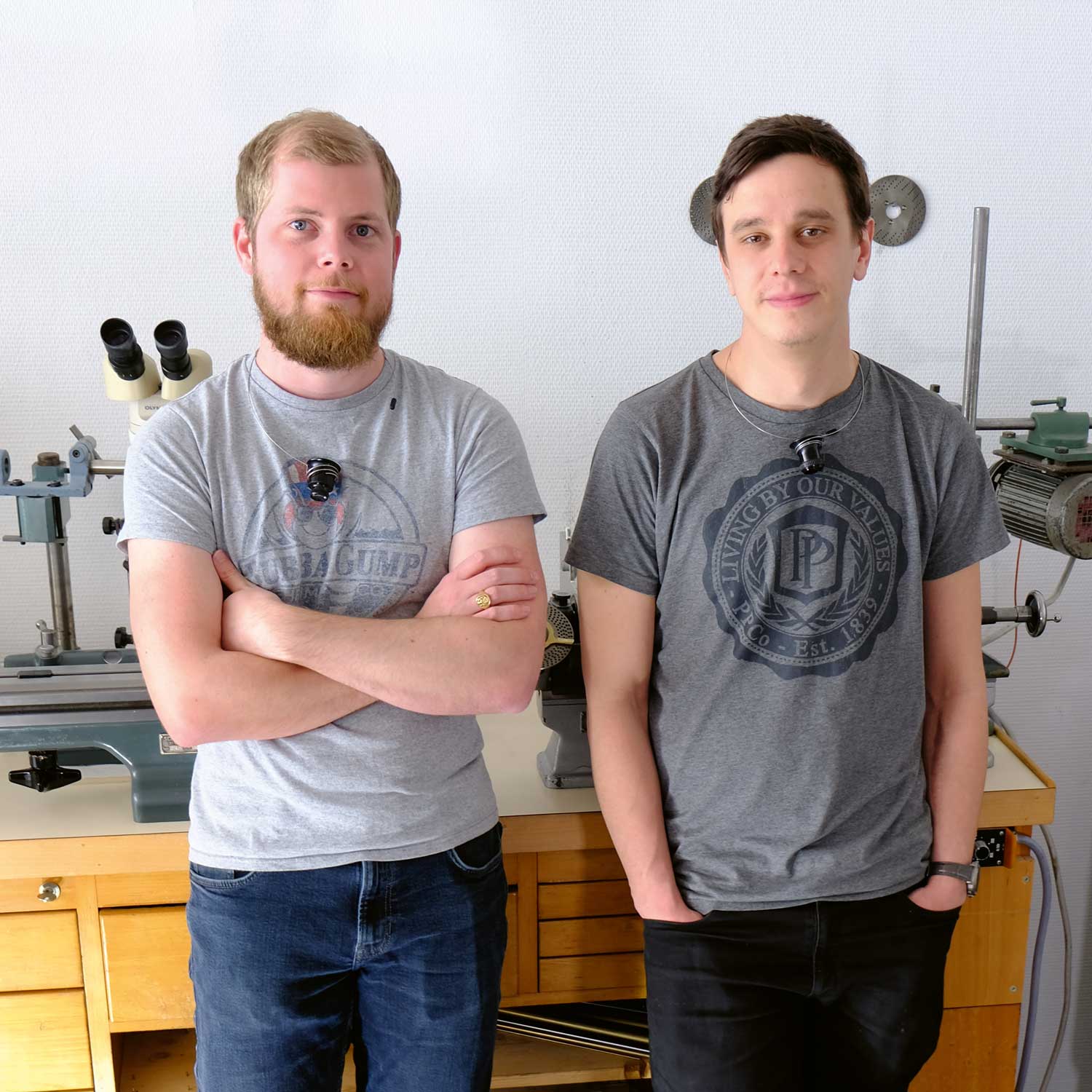
Gaël Petermann and Florian Bédat

Petermann Bedat Monopusher Split-Seconds Chronograph with Instantaneous Minutes Ref. 2941
As a result, the column wheel for the split seconds is visible through a semi-open dial at 12 o’clock. Produced by Comblémine, the dial factory owned by Kari Voutilainen, the dial plates are made of platinum and has a fine, frosted finish. It has a bi-compax layout with the instantaneous minute counter at three o’clock and the running seconds counter at nine, which has an aperture that reveals a black-polished cap for the escape wheel.
Shaped and finished by hand, the main hour, minutes and running seconds as well as the rattrapante hands are in blued steel while the hands for the chronograph seconds and minutes are distinguished in gold. A minor quirk arising from incorporating the split-seconds mechanism on the dial side is that the chronograph hand is positioned above the split seconds hand, contrary to the conventional arrangement. As such, the split hand, which is the more delicate hand, is executed in blued steel rather than gold.


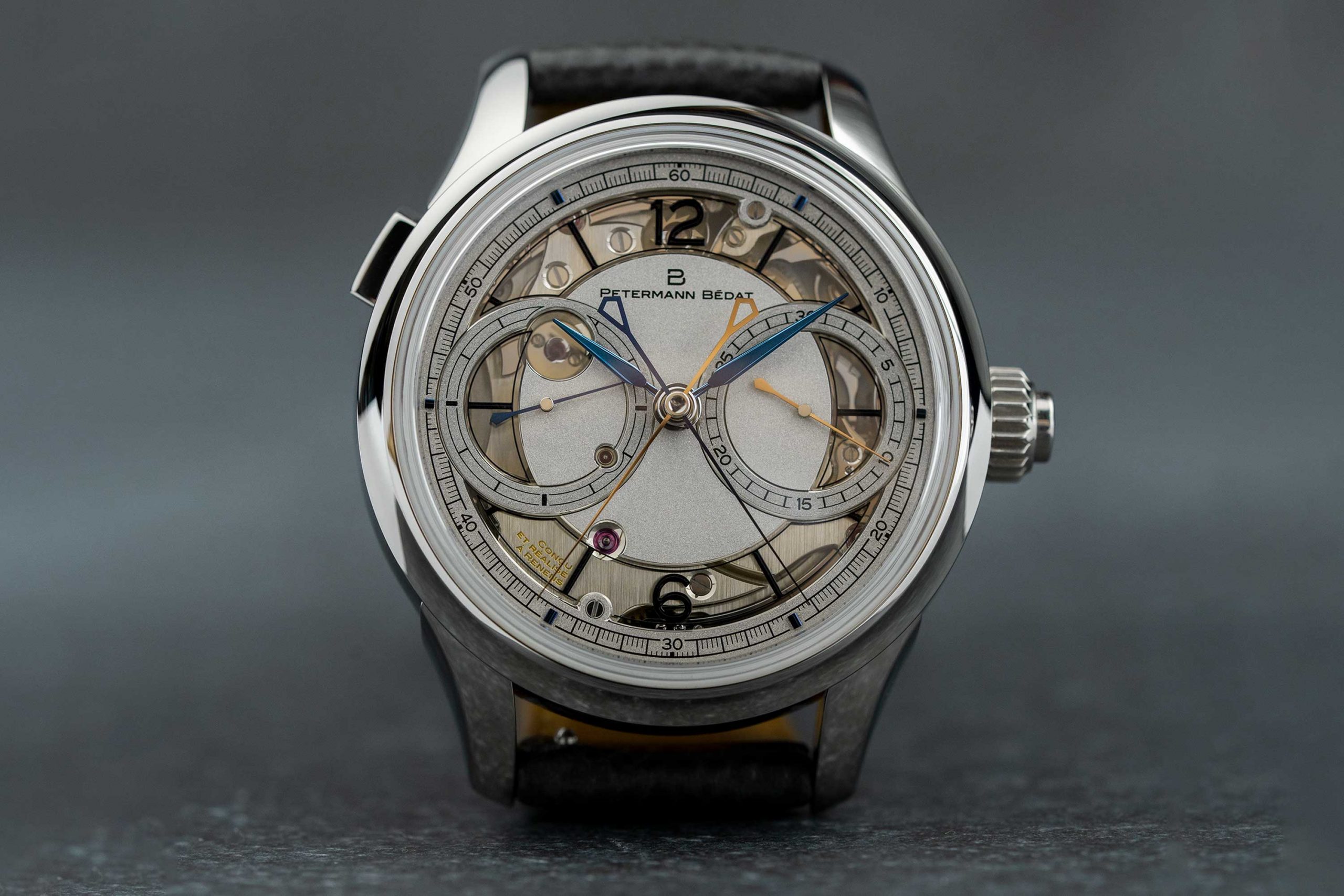
Petermann Bedat Monopusher Split-Seconds Chronograph with Instantaneous Minutes Ref. 2941
The movement is remarkably beautiful with tremendous attention paid to the aesthetics of every minute detail as well as their relationship to each other. The base plate and bridges are made from German silver, which imparts a soft golden hue, enabling the steel components to stand out. The wheel train, beginning with the mainspring barrel that has a massive top jewel visible on the case back, is laid out in an anti-clockwise direction with the great wheel located at 11 o’clock rather than the centre to reduce thickness. The chronograph drive wheel, escape wheel, chronograph seconds and minute wheels are held in place by individual bridges that are beautifully shaped; the boundary between the bridge for the chronograph seconds and the bridge for the minutes accommodates the minute ratchet wheel, enable the ratcheting to be observed.
The column wheel is located at 12 o’clock and controls several slim and elegant levers. The coupling lever is particularly elaborate and beautiful; it is fully support in that it pivots over the drive wheel and has a C-shaped tail that ends in two sharp outward angles. To the right, there are two slender and sinuous levers that intertwine around the barrel’s arbor jewel, displaying the meticulous consideration given to the visual harmony between the components. The lever furthermost to the right is the reset lever while the lever on its left is designed to isolate the ratchet minute wheel so that it be freely reset. This lever is only necessary in chronographs with an instantaneous minute counter.

35-Longines-Chrono-13ZN
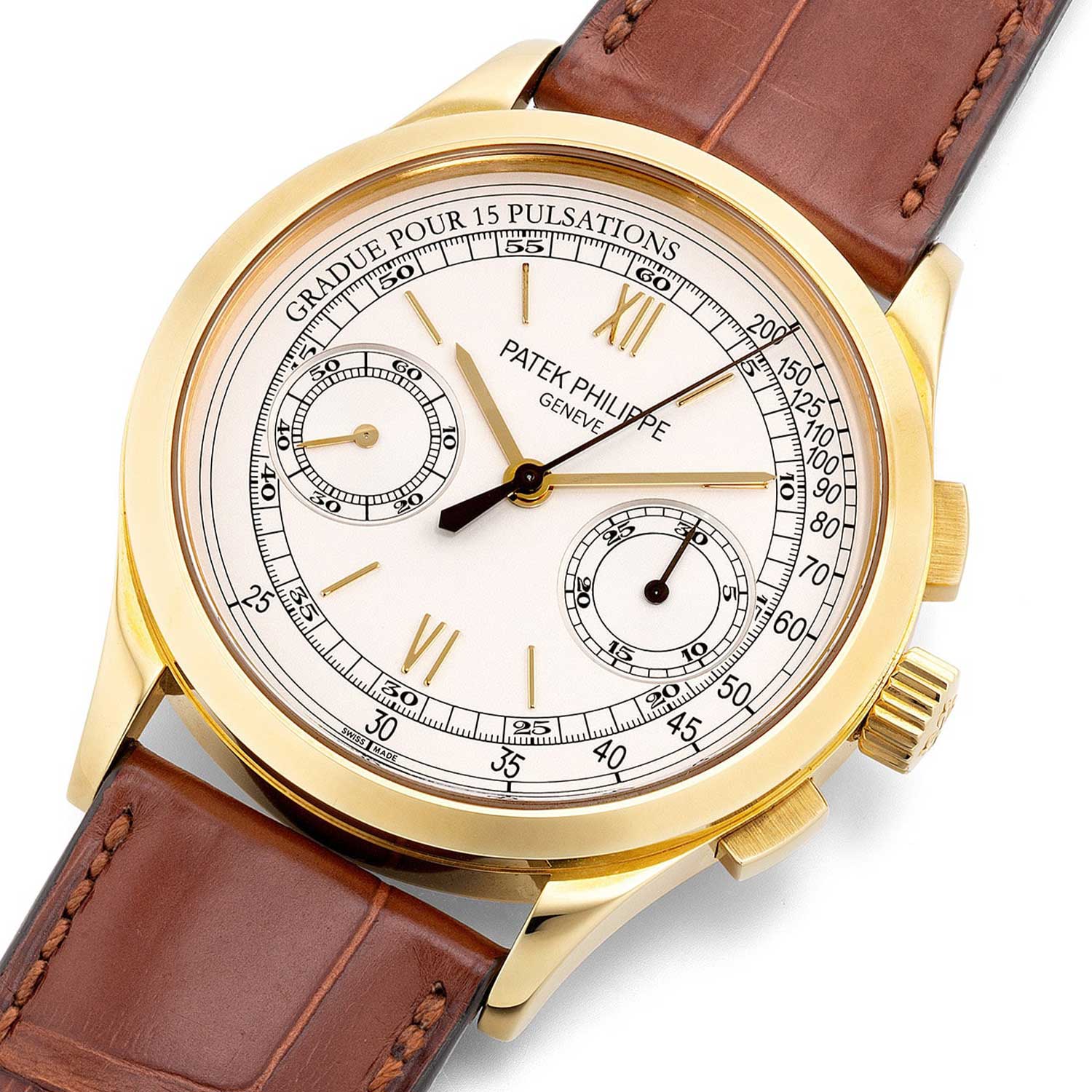
The 2010 Patek Philippe Ref. 5170J's dial is the only one in the reference to feature a combination of Roman Numerals and baton hour markers with a pulsation chronograph scale (Image: Phillips.com)
The instantaneous minute mechanism consists of a lever with a ratchet hook, a snail cam positioned on the chronograph seconds axis and a spring. The minute lever and spring are supported by the same bridge that holds the chronograph seconds wheel. The snail cam rotates along with the chronograph wheel and every minute when the peak of the snail cam comes into contact with the beak of the lever, it pushes the latter towards the ratchet wheel, pulling it forward by one tooth. This action is facilitated by a spring which also ensures that it exerts less tension and ratchet smoothly. The isolating lever mentioned earlier pivots on the minute lever and prevents it from engaging with the minute wheel when the chronograph is reset.
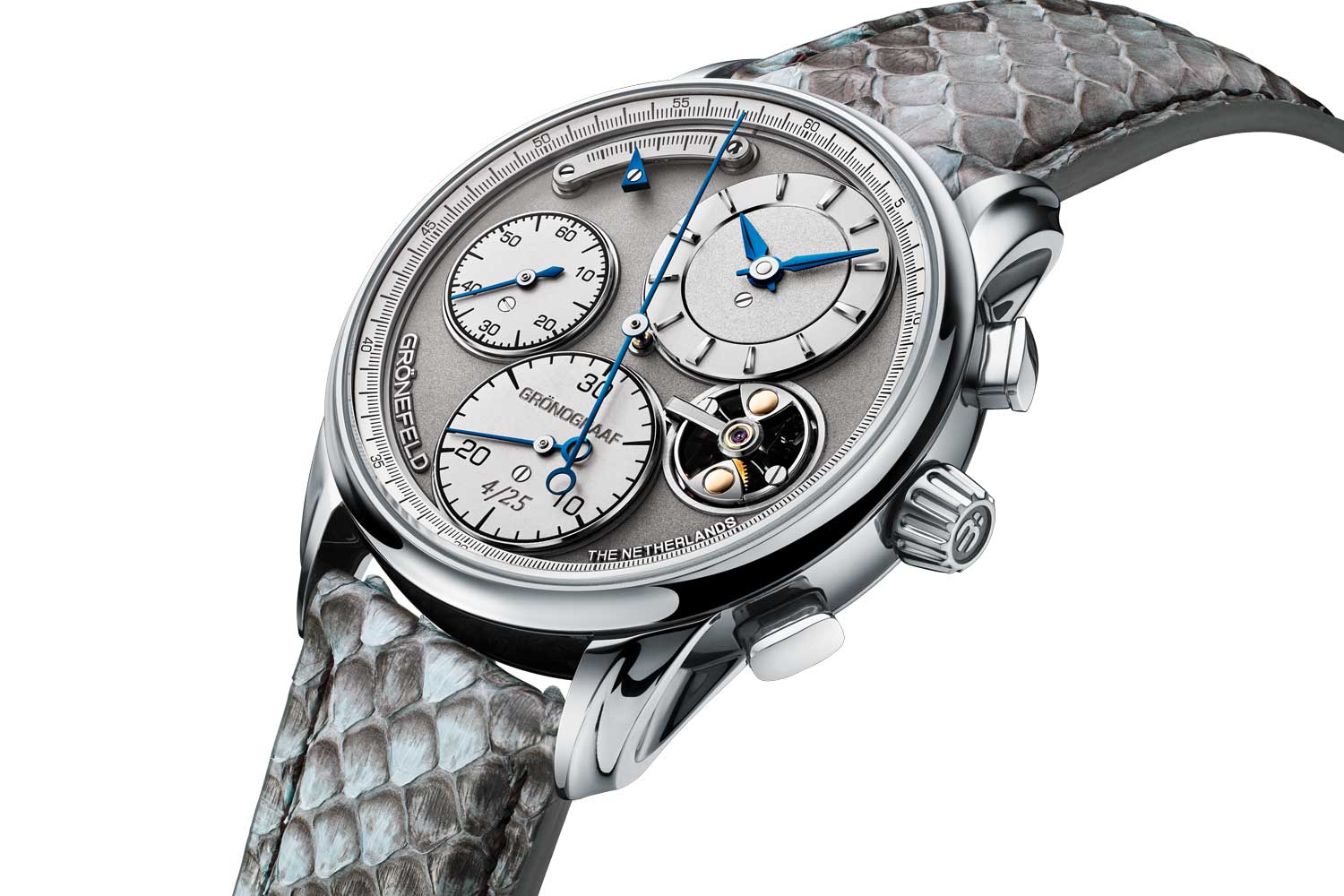
Grönefeld 1941 Grönograaf
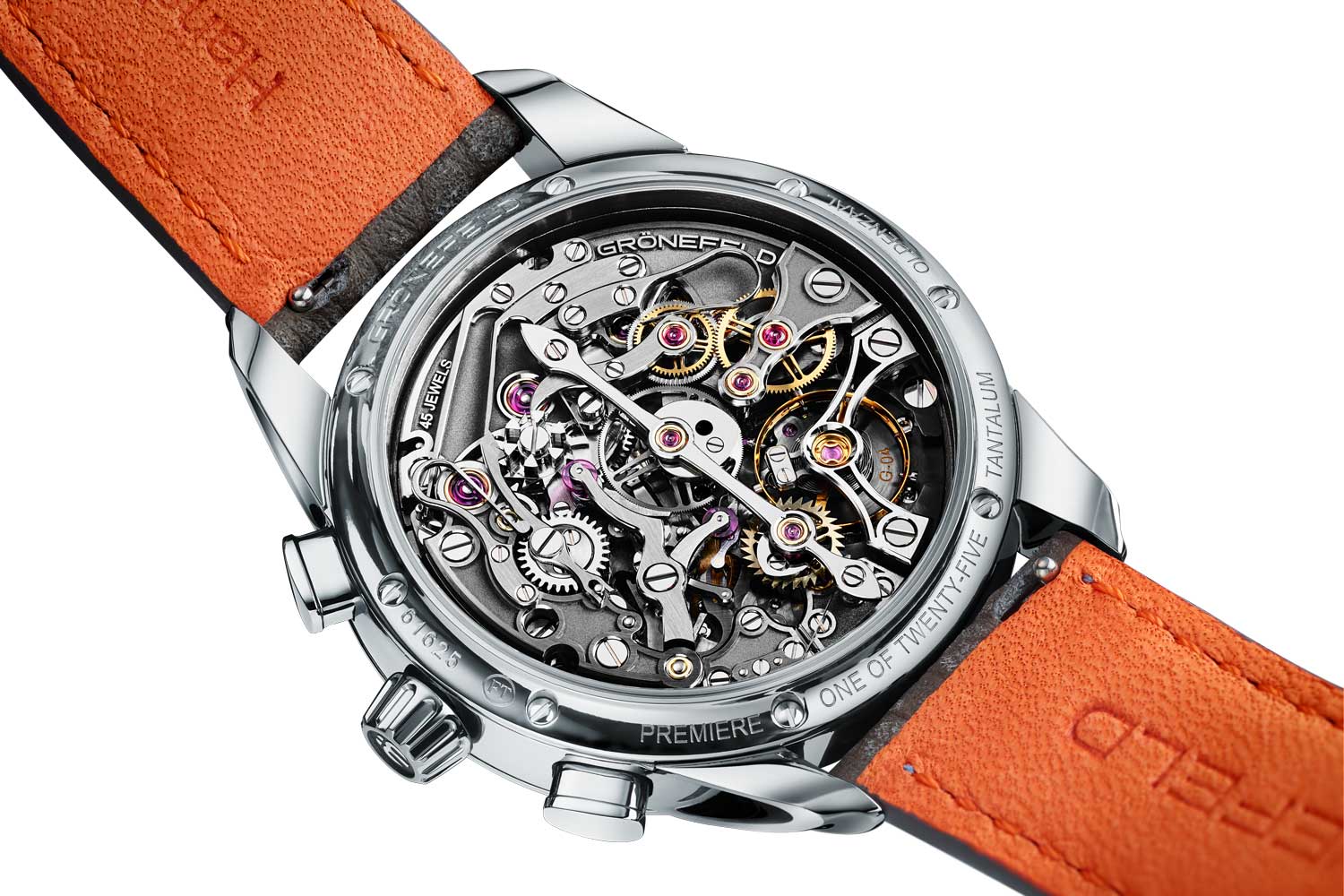
Grönefeld 1941 Grönograaf
On the movement’s dial side, held in place by a bridge at eight o’clock is an intermediate drive wheel for the main minute hand as the great wheel is located at 11 o’clock. The column wheel and split seconds mechanism are arranged right down the middle of the movement. The heart cam of the chronograph seconds wheel is located on this plate underneath the split seconds wheel. When the chronograph is activated, a spring-loaded lever affixed to the split wheel acts on the heart cam, allowing both wheel to rotate together. When the split is activated, a pair of clamp lever grips the split wheel, immobilizing it and the heart cam lifts the spring-loaded lever away from the centre of the wheel. Evident at this point is that there is no isolator to prevent friction caused by the lever dragging over the heart cam. Thus, the movement parts had to be constructed with utmost precision and finely finished.
At the top right, there’s a curious ratchet wheel that is part of a security system. Resetting the chronograph when the rattrapante has yet to catch up with the chronograph seconds hand can damage the movement as the rattrapante wheel is still being locked by clamp levers. Hence, a security system was installed to release the clamp levers in this scenario. When the chronograph is reset, a ratchet hook on the command lever pushes this security wheel with ratchet teeth which in turn will push a security finger. Meanwhile the column wheel is designed with milled teeth such that if the clamp levers are open, the finger will turn under a milled tooth but if the clamp levers are locked, it will push a solid tooth and the clamp levers will release the split wheel for reset.

The platinum seconds track and central dial plate are meticulously finished with a finely frosted top surface and wide, distinctly polished bevels
All told, the watch is simply a knockout, and particularly in terms of the amount of effort devoted to aesthetics, encompassing both design and finishing, it is hard to beat. It’s limited to 10 pieces, and deliveries are scheduled to commence this autumn.
Tech Specs
Petermann Bedat Monopusher Split-Seconds Chronograph with Instantaneous Minutes Ref. 2941
Movement: Hand-wound in-house Calibre 202; power reserve of 48 hours; 2.5Hz or 18,000vph
Functions: Hours, minutes, seconds, rattrapante chronograph with instantaneous minutes
Case: 38.6mm x 13.7mm; platinum
Dial: Platinum with frosted finish and hand-polished bevels
Strap: Alligator leather with platinum pin buckle
Availability: Limited to 10 pieces
Price: CHF 243,000 before taxes











